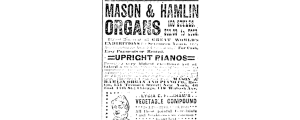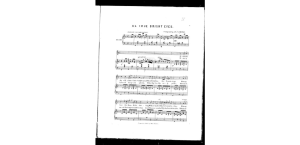As evident in Southern’s book, The Music of Black Americans, music-making has always been an important part of African American culture in the United States. One aspect of Southern’s writing that I found particularly interesting was her use of newspaper articles to highlight the values of a certain time, and how they related to music. During the time of slavery in the United States, most of the newspaper ads were written from a white enslaver’s perspective, however, after the Civil War and the onset of African American-based newspapers, black American perspectives began to shine through.
I chose to investigate a music advertisement from the Cleveland Gazette, published in 1883, that highlights this change in perspective. Bold letters that capture the audience’s attention read:
Lovers of music, secure at once a copy of the new edition of “Bright Eyes”.
Written by Cleveland Gazette editor Harry C. Smith, “Be True Bright Eyes” was a song for piano (or organ) with voice, and includes a score for four-part harmony. This push to buy piano and vocal music, in conjunction with other music related ads found in the Cleveland Gazette, such as the piano ad below, demonstrate the different types of music-making that black Americans participated in during this time period.

We have seen in Southern’s reading through newspaper ads that fiddle, banjo, and horn playing were popular instruments, and now through an African American lens, we also see the importance of piano playing with a vocal melody. Although primary sources written by white people, like the ads Southern uses, can give researchers important information, African American newspapers like the Cleveland Gazette are necessary sources to include in research because they highlight the narrative of black Americans. Researchers must always look to sources like the Cleveland Gazette that center black voices and experiences.
Works Cited
“Advertisement.” Cleveland Gazette (Cleveland, Ohio), October 18, 1884: 3. Readex: African American Newspapers. https://infoweb.newsbank.com/apps/readex/doc?p=EANAAA&docref=image/v2%3A12B716FE88B82998%40EANAAA-12CC2DCC9D4D1D28%402409468-12CBE5CDD45206C0%402-12E046B1ACAC4B68.
“Advertisement.” Cleveland Gazette (Cleveland, Ohio), October 18, 1884: 4. Readex: African American Newspapers. https://infoweb.newsbank.com/apps/readex/doc?p=EANAAA&docref=image/v2%3A12B716FE88B82998%40EANAAA-12CC2DCC9D4D1D28%402409468-12CBE5CDD4E6F7A8%403-12E046B291DEDFF8.
Encyclopedia of Cleveland History | Case Western Reserve University. “SMITH, HARRY CLAY,” May 11, 2018. https://case.edu/ech/articles/s/smith-harry-clay.
Smith, Harry C. Be True Bright Eyes. Smith, H. C., Cleveland, monographic, 1883. Notated Music. https://www.loc.gov/item/sm1883.01718/.
Southern, Eileen. The Music of Black Americans : a History. [1st edition]. New York: W. W. Norton, 1971.


